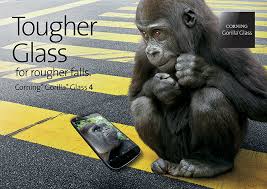By Anca Gagiuc on April 21, 2015 in Technology

One is tough, you drop it and it doesn’t shatter, the other is super resistant to scratches; one is named after a massive primate, the other after a wonderful gemstone. Gorilla Glass and Sapphire Glass are the two major product players in the tough glass race.
Gorrilla Glass is developed by Corning, a leading innovator in materials science. Corning has been continuously working on improving the toughness of their product, attempting to strengthen it to survive all types of disastrous scenarios. So far the company created the best product on the market, but has as principal flaw its low scratch resistance.
The latest update released by Corning is Gorilla Glass 4, introduced in November. This is one twice as strong as the previous generation, claimed the company, and survived the fall 80 percent of the time, unlike the soda-lime glass used in other phones which shattered in every test. However, the Glass 4 proved to be less resilient to scratches than the Gorilla Glass 3 and thus engineers went back to the drawing board.
Recently, Corning started focusing on the qualities of sapphire glass and looked for ways to insert the scratch-resistance feature into their product. Thus originated Project Phire, an initiative that wishes to combine Gorilla’s strength and the resistance of the sapphire.
The new material has been unveiled at a New York investor meeting, reports CNET. The new glass will start selling later this year, without specific details on price or date.
Why not synthetic sapphire?
According to Corning, even though synthetic sapphire is extremely resistant to scratches, it doesn’t hold up when dropped. And smartphones are dropped a lot. According to some analysts the price of the sapphire glass would increase painfully the price of the smartphone wearing it.
We can’t forget Apple’s attempt to cover its iPhone 6 and iPhone 6 Plus in sapphire glass by investing in the acquisition of GT Advanced Technology. That attempt that ended with the newest line of iPhones being covered in Corning’s product and with GT Advanced Technology filing for bankruptcy. Their explanation was (Apple-style) scarce, that the sapphire is too reflective. Still, the Touch ID sensor and the camera are made of sapphire glass.
Smartphones with full sapphire glass displays are not unseen on the market; the Kyocera Brigadier and the Vertu Signature Touch use it. And despite the collapse of GT Advanced Technologies, there are plenty analysts out there who continue to see the sapphire glass as a better product than Gorilla Glass.
Until further news, we can only imagine the strength and endurance of the sapphire gorilla.


